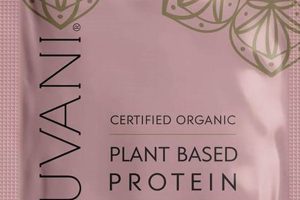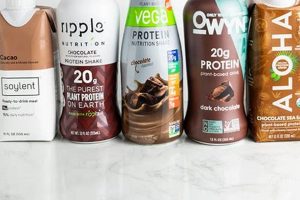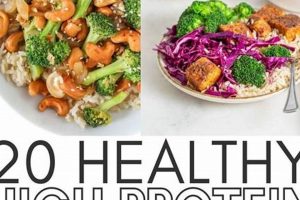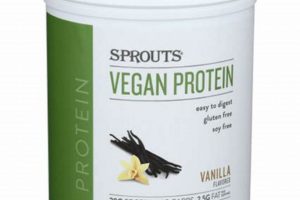The subject of this exploration concerns food products designed to align with both ketogenic and vegan dietary restrictions, while simultaneously providing a concentrated source of protein. These items typically utilize plant-based protein sources such as pea protein, brown rice protein, or soy protein isolate, and incorporate ingredients high in healthy fats and low in carbohydrates to maintain ketosis. For instance, a typical bar might contain almond butter, coconut oil, and a blend of plant-based proteins, sweetened with erythritol or stevia.
These specialized bars address the challenges of adhering to a ketogenic diet, which restricts carbohydrate intake to induce a metabolic state of ketosis, combined with a vegan lifestyle, which excludes all animal-derived products. Historically, combining these dietary frameworks presented difficulties in finding convenient and palatable protein sources. The rise in demand for plant-based and low-carbohydrate options has driven the development and increasing availability of these items, offering a convenient way to supplement protein intake, manage macronutrient ratios, and satisfy hunger between meals.
Further discussion will delve into the nutritional composition, common ingredients, potential health considerations, and market availability of these specialized food products. This includes an analysis of ingredient selection to ensure compliance with both ketogenic and vegan requirements, as well as an examination of the potential impact on blood sugar levels and overall metabolic health. The scope also encompasses consumer considerations, such as taste, texture, and price, and the evolving landscape of this niche food category.
Guidance on Keto Vegan Protein Bars
The following recommendations are intended to provide informed guidance on selecting and integrating these specialized nutritional products into a balanced dietary regimen. Careful consideration of ingredients, macronutrient profiles, and individual health requirements is paramount.
Tip 1: Evaluate Ingredient Lists Meticulously: Examine the ingredient list for hidden sources of carbohydrates or non-vegan components, such as honey or dairy-derived additives. Opt for bars utilizing plant-based sweeteners like erythritol, stevia, or monk fruit, and ensure the protein source is derived from vegan-compatible ingredients.
Tip 2: Scrutinize Macronutrient Ratios: Prioritize bars that align with the target ketogenic macronutrient distribution, typically high in fat, moderate in protein, and very low in net carbohydrates. Calculate net carbohydrates by subtracting fiber and sugar alcohols from the total carbohydrate count.
Tip 3: Assess Protein Content and Source Quality: Aim for bars providing a sufficient protein quantity to support satiety and muscle maintenance. Pea protein, brown rice protein, and pumpkin seed protein are viable options, but consider protein bioavailability and amino acid profiles.
Tip 4: Consider Added Fats: Evaluate the source and type of fats included in the product. Coconut oil, MCT oil, almond butter, and avocado oil are preferable due to their healthy fat content and contribution to ketone production.
Tip 5: Be Mindful of Artificial Additives: Minimize consumption of bars containing artificial colors, flavors, or preservatives. Opt for products with natural and recognizable ingredients to mitigate potential adverse health effects.
Tip 6: Monitor Blood Glucose Response: Individuals with diabetes or insulin resistance should carefully monitor blood glucose levels after consuming these bars to assess individual tolerance and impact on glycemic control.
Tip 7: Consider Allergen Information: Individuals with allergies or sensitivities should carefully review allergen statements to avoid potential reactions. Common allergens include soy, nuts, and seeds.
The careful selection and mindful consumption of these bars can contribute to a well-managed ketogenic and vegan dietary approach. However, they should not replace whole, unprocessed foods as the foundation of a healthy eating pattern.
Further sections will address specific product reviews, recipe adaptations, and strategies for incorporating these products into a comprehensive meal plan.
1. Ingredient Sourcing
Ingredient sourcing is a critical determinant of the quality, sustainability, and ethical implications associated with products designed for both ketogenic and vegan diets. The specific sources of protein, fats, sweeteners, and other additives profoundly impact the nutritional value and overall suitability of these items for health-conscious consumers.
- Protein Source Origin and Processing
The origins of plant-based protein sources like pea, brown rice, or soy directly influence the amino acid profile and potential for allergen contamination. The processing methods used to isolate and concentrate these proteins, such as chemical extraction or enzymatic hydrolysis, can affect the final product’s purity and nutritional integrity. Suppliers employing sustainable agricultural practices and minimizing chemical inputs are preferable.
- Fat Source and Quality Assurance
The sources of fats, typically coconut oil, MCT oil, or nut butters, must be scrutinized for quality and potential contaminants. Cold-pressed, unrefined oils from certified organic sources ensure minimal processing and preservation of beneficial fatty acids. Rigorous testing for heavy metals and pesticides is essential to ensure consumer safety and product integrity.
- Sweetener Origin and Refinement
The origin and refinement processes for low-carbohydrate sweeteners, like erythritol, stevia, or monk fruit, significantly impact their environmental footprint and potential for residual solvents or contaminants. Suppliers committed to sustainable harvesting practices and employing gentle extraction methods that minimize chemical use are preferable.
- Additives and Flavorings Transparency
The sources of additives, natural flavorings, and preservatives should be clearly identified. Prioritizing manufacturers that source these components from reputable suppliers and disclose their exact composition enhances transparency and allows consumers to make informed choices regarding potential allergens or undesirable ingredients.
In conclusion, the meticulous sourcing of ingredients for these bars is not merely an operational detail but a fundamental aspect of their quality, nutritional value, and ethical considerations. Manufacturers prioritizing transparency, sustainability, and rigorous testing procedures can deliver products that align with the values and health goals of discerning consumers.
2. Macronutrient Balance
Macronutrient balance constitutes a foundational element in the formulation and consumption of food products designed for combined ketogenic and vegan dietary patterns. These bars, intended to reconcile the constraints of both diets, necessitate careful calibration of fats, proteins, and carbohydrates to induce and maintain ketosis while adhering to plant-based principles. The efficacy of these bars hinges on their ability to provide a high proportion of calories from fat, a moderate amount from protein, and minimal carbohydrates, a distribution essential for shifting the body’s primary fuel source from glucose to ketones. Failure to maintain this balance will preclude the metabolic state of ketosis.
An imbalance in macronutrient ratios can undermine the intended metabolic effects. For example, an excess of carbohydrates, even from sources deemed vegan-friendly such as certain fruits or grains, can elevate blood glucose levels, thereby inhibiting ketone production. Conversely, insufficient fat intake can compromise satiety and energy levels, potentially leading to increased carbohydrate cravings and dietary non-compliance. A real-life example involves bars containing significant amounts of dried fruit as a “natural” sweetener; these may inadvertently introduce a carbohydrate load that prevents or interrupts ketosis. A properly formulated bar will emphasize fats from sources like coconut oil, almond butter, or avocado oil, while keeping carbohydrate content exceptionally low through the use of non-nutritive sweeteners and high-fiber ingredients.
Achieving optimal macronutrient balance in these specialized bars presents several challenges. Sourcing plant-based ingredients that naturally align with the required high-fat, low-carbohydrate profile is inherently complex. The selection of protein sources, typically pea protein or other plant isolates, requires attention to amino acid profiles while also minimizing carbohydrate contribution. Ultimately, the practical significance of understanding macronutrient balance in the context of these bars lies in its direct impact on their effectiveness as a tool for achieving and sustaining ketosis within a vegan dietary framework. Careful attention to product labeling and ingredient lists, combined with individual monitoring of ketosis through blood or urine testing, remains essential for successful implementation.
3. Protein Bioavailability
Protein bioavailability is a critical factor in evaluating the nutritional efficacy of products designed for combined ketogenic and vegan diets. These bars, aiming to provide a concentrated source of protein while adhering to the constraints of both dietary regimens, must deliver protein in a form that is readily digestible and absorbable by the body. The protein bioavailability of these bars directly influences their ability to support muscle maintenance, satiety, and overall metabolic health. A protein source with low bioavailability, regardless of its quantity, will have limited physiological benefit.
The protein sources commonly utilized in these bars, such as pea protein, brown rice protein, and soy protein isolate, exhibit varying degrees of bioavailability. Plant-based proteins often contain inherent compounds, such as phytates or tannins, that can inhibit protein digestion and absorption. Processing methods, such as enzymatic hydrolysis, can improve the bioavailability of these proteins by breaking down complex structures and reducing the impact of antinutritional factors. For example, raw legumes typically have lower bioavailability, compared to properly cooked and processed legumes in plant-based proteins. Bars utilizing these protein sources must consider these factors to maximize the protein’s utility within the body. Furthermore, combining different plant-based protein sources can enhance the overall amino acid profile, addressing potential deficiencies in individual sources and improving protein utilization.
In conclusion, protein bioavailability is not merely a secondary consideration but a primary determinant of the nutritional value of keto vegan protein bars. Optimizing protein bioavailability through careful selection of protein sources, appropriate processing techniques, and strategic blending of complementary proteins is essential for ensuring that these bars effectively contribute to the health and well-being of individuals adhering to both ketogenic and vegan dietary guidelines. Consumer awareness and informed product selection are vital for reaping the intended benefits of these specialized food products.
4. Sweetener Type
The selection of sweeteners in formulating bars for combined ketogenic and vegan diets is critical due to its direct impact on both metabolic and ethical considerations. The ideal sweetener must contribute minimal or no net carbohydrates to avoid disrupting ketosis, while simultaneously adhering to vegan principles by excluding animal-derived ingredients like honey. Common sweeteners employed in these products include erythritol, stevia, monk fruit extract, and xylitol. Each possesses distinct characteristics influencing the overall suitability of the bar for its intended dietary purpose. The choice of sweetener is a decisive factor, because inappropriate sweeteners can lead to either disruption of ketosis or a violation of vegan principles.
The glycemic impact of the sweetener is paramount. Erythritol, a sugar alcohol, is largely non-metabolized and thus contributes negligible net carbohydrates, making it a frequently employed choice. Stevia and monk fruit extract, being natural non-nutritive sweeteners, similarly offer minimal impact on blood glucose levels. Xylitol, while possessing a lower glycemic index than sucrose, may still contribute some net carbohydrates and, importantly, is toxic to dogs, posing a risk in households with pets. Certain manufacturers might employ less suitable sweeteners such as agave nectar or brown rice syrup under the guise of “natural” ingredients; however, these contribute significant carbohydrates and are unsuitable for ketogenic diets. Furthermore, some bulk sweeteners, like maltitol, can cause digestive distress in some individuals. Therefore, ingredient lists require careful scrutiny to ascertain the precise sweetener used and its potential metabolic effects. The use of a “keto-friendly” sweetener is of great benefit for the consumer.
The selection of sweetener within these food products represents a critical balancing act between metabolic requirements, ethical considerations, and potential consumer health outcomes. Opting for sweeteners with negligible glycemic impact and confirmed vegan status is essential for maintaining both ketosis and adherence to plant-based dietary principles. Consumers are advised to critically evaluate product labeling and conduct informed research to ensure that the chosen product aligns with their specific dietary needs and ethical values. The understanding of these sweeteners and their effects is an ongoing field of study, and constant vigilance is key.
5. Texture & Palatability
Texture and palatability are paramount in determining the consumer acceptance and long-term adherence to any dietary regimen, particularly one as restrictive as a combined ketogenic and vegan approach. These attributes are critical in the formulation of food bars designed to meet these dietary requirements, as they directly influence the sensory experience and overall satisfaction derived from consuming these products. Overcoming the inherent challenges in achieving appealing texture and taste profiles using exclusively plant-based, low-carbohydrate ingredients is essential for the success of these items.
- Impact of Plant-Based Protein Sources on Texture
Plant-based protein sources, such as pea protein or brown rice protein, often contribute a characteristic graininess or dryness to the final product texture. This is due to the inherent properties of these proteins and the processing methods required to isolate them. Overcoming this requires careful formulation, often involving the use of binding agents like gums or fibers to improve cohesiveness and mouthfeel. Inadequate attention to this facet can result in a bar that is perceived as unpleasantly gritty or dry, negatively impacting consumer acceptance.
- Role of Fats in Palatability and Mouthfeel
Fats play a significant role in contributing to the palatability and mouthfeel of food products, particularly in ketogenic formulations where fat intake is emphasized. Vegan sources of fats, such as coconut oil, almond butter, or avocado oil, can impart distinct flavors and textures. The judicious use of these fats can enhance the overall sensory experience, masking any undesirable flavors or textures from other ingredients. Conversely, improper fat selection or inadequate fat content can result in a bar that is either excessively oily or unacceptably dry and crumbly.
- Sweetener Influence on Texture and Taste
The type of sweetener employed significantly influences both the texture and taste of the bar. Sugar alcohols like erythritol or xylitol can contribute a cooling sensation or a slightly bitter aftertaste, while non-nutritive sweeteners like stevia or monk fruit extract can exhibit unique flavor profiles that may not be universally appealing. The selection and concentration of sweeteners must be carefully calibrated to achieve a balanced flavor profile that is palatable without contributing excessive carbohydrates or undesirable textural attributes. Some can contribute a gritty texture if not properly milled or incorporated.
- Fiber’s Dual Role: Texture and Health
Fiber is often added to ketogenic bars to increase satiety and improve digestive health. However, high fiber content can also negatively impact texture, leading to a dry or crumbly product. Balancing the health benefits of fiber with the need for an acceptable texture is crucial. Ingredient examples of texture modification with fiber include using finely ground fibers, or specific types of fiber known for their binding capabilities.
The interplay between texture and palatability is a critical determinant of the success of bars designed for combined ketogenic and vegan diets. A well-formulated bar will skillfully address the challenges posed by plant-based protein sources, carefully select fats to enhance mouthfeel and flavor, and judiciously incorporate sweeteners to achieve a balanced taste profile. By prioritizing these sensory attributes, manufacturers can create products that are not only nutritionally sound but also enjoyable to consume, thereby promoting long-term adherence to these restrictive dietary patterns.
6. Digestibility
Digestibility represents a significant consideration in the formulation and consumption of products tailored for both ketogenic and vegan dietary approaches. The inherent characteristics of plant-based ingredients, coupled with the metabolic demands of ketosis, necessitate careful attention to the digestive impact of these bars. Optimal digestibility ensures efficient nutrient absorption, minimizes gastrointestinal distress, and supports overall well-being.
- Fiber Content and its Effects
The fiber content significantly influences the digestibility of these bars. While fiber is beneficial for promoting satiety and regulating blood sugar levels, excessive amounts, particularly from insoluble sources, can lead to bloating, gas, and abdominal discomfort. The type of fiber is also relevant; for instance, inulin or resistant starch may be poorly tolerated by some individuals. A balanced approach, incorporating both soluble and insoluble fibers in moderate amounts, is generally recommended to optimize digestive comfort.
- Plant Protein Sources and Enzyme Activity
Plant-based protein sources, such as pea, brown rice, or soy protein, contain complex carbohydrates and antinutritional factors that can impede digestion. These factors may inhibit the activity of digestive enzymes, reducing protein absorption and potentially causing gastrointestinal upset. Processing techniques, such as enzymatic hydrolysis or fermentation, can mitigate these effects by breaking down complex molecules and neutralizing antinutritional compounds, thereby enhancing protein digestibility.
- Fat Composition and Bile Acid Production
The high-fat content, characteristic of ketogenic diets, places additional demands on the digestive system, particularly bile acid production. Adequate bile acid secretion is essential for emulsifying fats, facilitating their absorption in the small intestine. Individuals with compromised gallbladder function or impaired bile acid production may experience digestive difficulties, such as nausea or steatorrhea, when consuming these bars. Medium-chain triglycerides (MCTs) are often incorporated due to their easier digestion and absorption compared to long-chain triglycerides.
- Artificial Sweeteners and Gut Microbiome
Certain artificial sweeteners, frequently employed in these bars to minimize carbohydrate content, can exert adverse effects on the gut microbiome. These sweeteners may disrupt the balance of beneficial bacteria, leading to dysbiosis and associated gastrointestinal symptoms, such as diarrhea or abdominal pain. The impact of specific sweeteners on the gut microbiome varies; some may be better tolerated than others. Consideration of the potential impact on gut health is warranted when selecting products containing artificial sweeteners.
Digestibility is not simply a passive characteristic but an active consideration that significantly impacts the overall value and tolerability of bars designed for both ketogenic and vegan diets. Formulations prioritizing easily digestible ingredients, appropriate fiber balance, and mindful sweetener selection can contribute to improved digestive comfort, enhanced nutrient absorption, and sustained adherence to these restrictive dietary patterns. Awareness of individual digestive sensitivities is essential for making informed product choices and optimizing the benefits of these specialized food products.
7. Ethical Production
Ethical production assumes paramount importance in the context of keto vegan protein bars, transcending mere product formulation to encompass the holistic impact of their creation. This consideration integrates environmental stewardship, fair labor practices, and responsible sourcing of ingredients, reflecting a commitment to sustainability and social responsibility within the supply chain.
- Sustainable Ingredient Sourcing
Ethical production necessitates the sourcing of ingredients, such as plant-based proteins and fats, from suppliers adhering to sustainable agricultural practices. This includes minimizing pesticide use, promoting biodiversity, and conserving water resources. Examples involve sourcing pea protein from farms employing regenerative agriculture techniques, which enhance soil health and reduce carbon emissions. The absence of such considerations can lead to deforestation, soil degradation, and adverse impacts on local ecosystems.
- Fair Labor Practices
Ethical production demands adherence to fair labor standards throughout the supply chain, ensuring that workers involved in ingredient cultivation, processing, and manufacturing receive fair wages, safe working conditions, and protection against exploitation. An example is verifying that coconut oil used in these bars is sourced from farms where workers are paid a living wage and provided with adequate safety equipment. Failure to uphold these standards perpetuates social injustice and undermines the integrity of the product.
- Waste Reduction and Packaging
Ethical production necessitates minimizing waste generation throughout the manufacturing process and employing sustainable packaging materials. This includes reducing food waste during production, utilizing recyclable or compostable packaging, and minimizing the use of single-use plastics. An example is employing biodegradable packaging made from plant-based materials, thereby reducing the environmental impact of waste disposal. Neglecting these aspects contributes to pollution and depletes natural resources.
- Animal Welfare Considerations
While these bars are vegan, ethical production extends to considering animal welfare across the broader supply chain. This means avoiding ingredients or processes that indirectly contribute to animal exploitation or harm. An example would be ensuring that any enzymes or processing aids used in the manufacturing process are not derived from animal sources and do not involve animal testing. Failure to consider these aspects compromises the integrity of the vegan ethos.
These facets underscore that ethical production is not merely a marketing tactic but a core principle that should guide the creation of keto vegan protein bars. By prioritizing sustainability, fair labor, waste reduction, and animal welfare, manufacturers can deliver products that align with the values of conscious consumers and contribute to a more equitable and environmentally responsible food system.
Frequently Asked Questions
The following questions address common inquiries and misconceptions regarding the composition, suitability, and potential effects of these specialized nutritional products. The information presented aims to provide clarity and assist informed decision-making.
Question 1: Are all bars labeled as “keto vegan” genuinely compliant with both dietary restrictions?
No. Products labeled as such may still contain ingredients that are either not strictly vegan (e.g., honey) or that exceed acceptable carbohydrate limits for ketogenic diets (e.g., high-glycemic fruit purees). Careful scrutiny of ingredient lists and macronutrient profiles is essential.
Question 2: Can these bars serve as a complete meal replacement?
Generally, no. While these bars can provide a convenient source of protein and fats, they often lack the full spectrum of nutrients found in whole, unprocessed foods. Reliance on these bars as a primary food source is not advised.
Question 3: Do all of these bars contain artificial sweeteners?
Not necessarily. Some formulations utilize natural, non-nutritive sweeteners such as stevia or monk fruit extract. However, artificial sweeteners like sucralose or aspartame are also commonly employed. Ingredient lists should be carefully examined to determine the specific sweeteners used.
Question 4: Are there potential digestive issues associated with consuming these bars?
Yes. High fiber content, sugar alcohols, or certain plant-based protein sources can cause gastrointestinal distress in some individuals. Starting with small portions and monitoring individual tolerance is recommended.
Question 5: Can these bars be consumed by individuals with nut allergies?
Many such bars contain nuts or are manufactured in facilities that also process nuts. Individuals with nut allergies should exercise extreme caution and thoroughly review allergen statements before consumption.
Question 6: How should these bars be incorporated into a ketogenic vegan diet?
These bars should be viewed as a supplemental source of protein and fats, complementing a diet primarily composed of whole, unprocessed plant-based foods. Moderation and careful consideration of overall macronutrient intake are essential for maintaining ketosis.
These responses underscore the importance of careful product evaluation and individual dietary considerations when incorporating these bars into a ketogenic and vegan lifestyle. Reliance on these products should be balanced with a commitment to whole food consumption.
The subsequent section will provide specific product recommendations and strategies for optimizing their use within a comprehensive dietary plan.
Conclusion
The preceding analysis has illuminated the multifaceted considerations surrounding keto vegan protein bars. These specialized food products, designed to simultaneously satisfy ketogenic and vegan dietary requirements, present both opportunities and challenges. Their utility as convenient protein sources must be weighed against potential drawbacks, including reliance on processed ingredients, the presence of artificial additives, and variable protein bioavailability. Careful product evaluation and individual dietary awareness remain paramount.
Ultimately, the long-term success of integrating keto vegan protein bars into a sustainable dietary pattern hinges on informed consumer choices and ongoing research. A commitment to whole, unprocessed plant-based foods should serve as the cornerstone of any dietary approach, with these bars used judiciously as a supplemental option. Continued innovation and refinement of product formulations are essential to enhance their nutritional profile, improve digestibility, and ensure ethical sourcing. Only through such advancements can these products meaningfully contribute to the health and well-being of individuals pursuing both ketogenic and vegan lifestyles.




![Boost Protein: Vegan Alfredo Recipe [Healthy & Easy!] Discover Delicious Vegan Food, Beauty Swaps, and Zero-Waste Tips for a Greener Life Boost Protein: Vegan Alfredo Recipe [Healthy & Easy!] | Discover Delicious Vegan Food, Beauty Swaps, and Zero-Waste Tips for a Greener Life](https://thisvegangirl.com/wp-content/uploads/2025/12/th-956-300x200.jpg)


